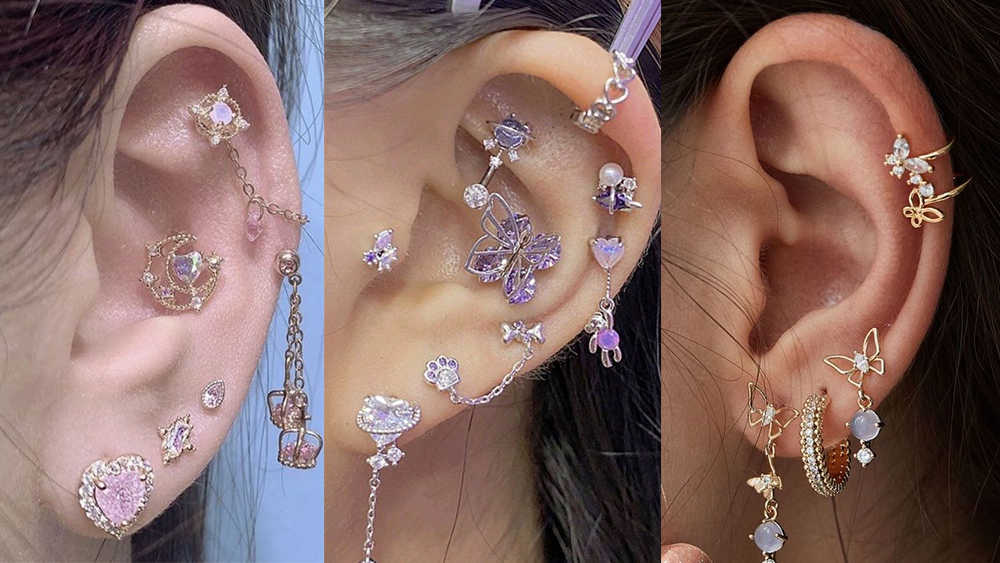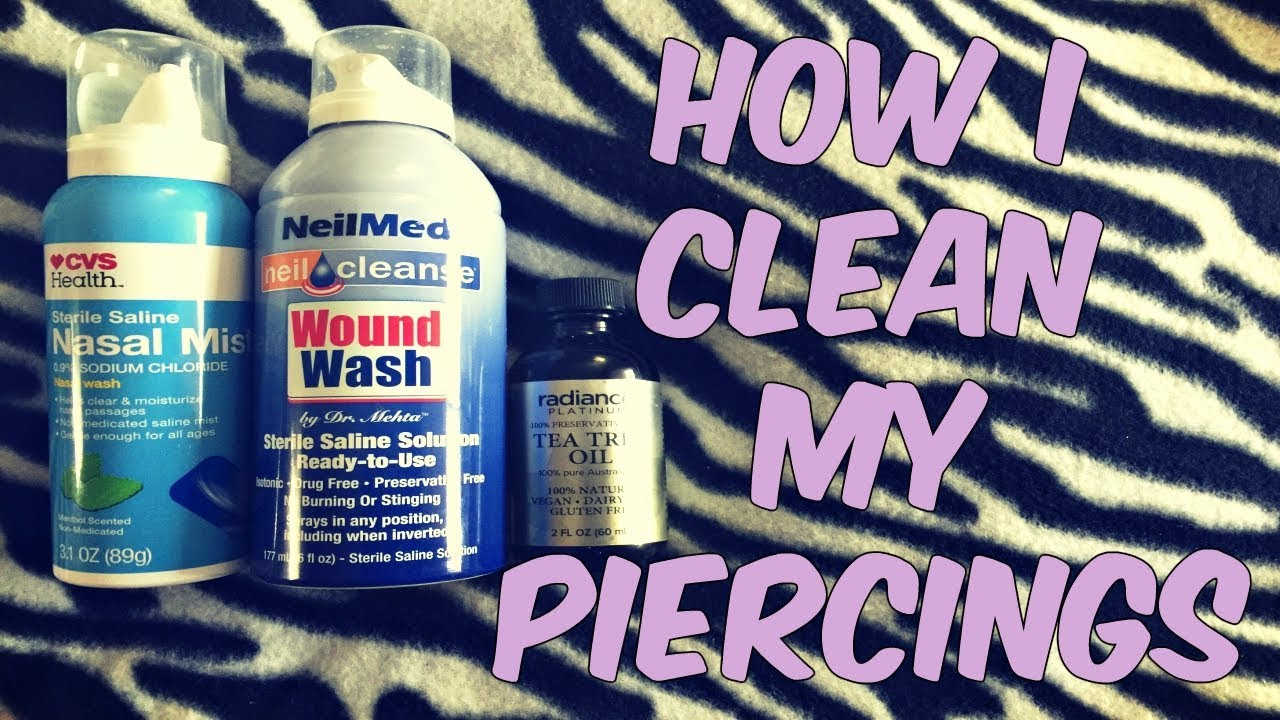Why the Ear Piercing will Close up?
The process of ear piercing healing
The healing process depends on you and how well you take care of your piercing. Cleaning the piercing with saline water is essential for a speedy recovery. Following your piercer’s instructions religiously will decrease the healing time of the piercing.
You should also avoid touching the piercing too much as by doing that, you may introduce bacteria, which will prolong your healing process. Generally, if you want to remove your earrings, you need to be extra cautious and clean; by doing this, you will be able to change your earrings overnight without the piercing closing up.
The position of the ear piercing
The position or the location of the ear piercing has significant effects on how long your piercing will take to heal. There are several positions in which you can pierce the ear; it all depends on where your piercing is done.
Some of the positions where the ear piercing is performed take a longer time to heal, like conch orbital piercing, which is also a painful piercing.
So you get to decide which position to pierce according to your taste and preference; regardless of what piercing you choose, you should know how long the piercing will take to heal so that you can understand when to remove your earrings and when not to take them off.
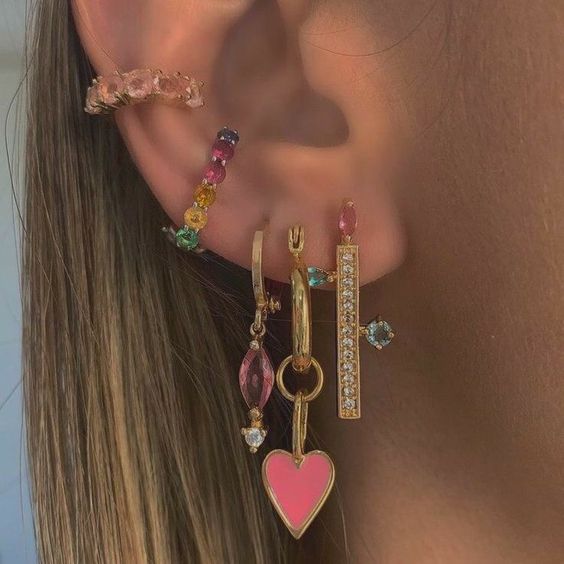
How old is the ear piercing
Any piercing that is less than six weeks should not be tampered with. The time in which your piercing was done also has an impact on whether you should remove your ring or not. It is, however, essential to keep your earrings in the piercing if they are less than six weeks old.
New ear piercing holes are more likely to close quickly
If you’ve ever gotten your ears pierced, you know how important it is to keep earrings in for a while. But why are new piercings so eager to close up in the first place?
“If you have a brand new piercing, your hole can close in a few hours,” Studs co-founder and CMO, Lisa Bubbers, told TODAY Style.”When you create a hole in your ear, your immune system kicks into gear and tries to heal and repair that hole.”
The rate at which a piercing heals varies from person to person and can also depend on what type of piercing you get, but typically, a new earlobe piercing will heal in 6-12 weeks. Piercings further up the ear (especially those involving cartilage) can take several months.
To help speed up the healing process, Bubbers recommends wearing earrings made of implant-grade metal so your body will form a healed layer around the metal. You also should avoid going any longer than 24 hours without wearing earrings for the first six months of a new piercing to prevent the hole from closing.
Can older ear piercing holes close
You may think you’re in the clear once your new piercing fully heals, but according to Jef Saunders, professional piercer and public relations coordinator for the Association of Professional Piercers, there’s a difference between the words “healed” and “permanent.”
“By healing, we mean that the channel of the piercing (what piercers call the fistula) is intact and no longer in the healing process. Most people can tell their piercing has healed when there is no redness, the tissue feels normal in the area of the piercing and the normal healing discharge (crust that gathers on the jewelry) has subsided,” he said. “A piercing becoming permanent, where jewelry can be removed for hours or days, is never guaranteed.”
And that means there’s always a chance that your piercing can close when you remove jewelry for an extended period of time.
“In my career as a piercer, I’ve seen 20-year-old healed ear piercings close up over a weekend, and I’ve seen six-week-old cheek piercings remain out for an eight-hour work shift and then be reinserted with ease. Both of those things were totally shocking to me, but they happened,” Saunders said.
It’s hard to predict how quickly your body will attempt to close a piercing, but as a general rule, the newer it is, the more likely it will close up. For instance: If your piercing is less than a year old, it can close in a few days, and if your piercing is several years old, it can take several weeks.
Will the earring holes close overnight?
You need to wear your rings on, especially if it is a new piercing. Removing them before the complete healing of the piercing may result in it closing up. If you decide to remove the rings before the piercing is complete, for example, removing the ring at 1-2 weeks will result in the closing up of the piercing.
There are different types of ear piercing, and each of them has different healing times. Any decision to remove the ring will require the piercing to be fully healed; other than that, you may have to undergo another re-piercing, which is not an easy process.
The types of ear piercing include ear lobe, conch orbital, rook, and tragus. Conch orbital is the most delicate piercings and is also very painful, after which the rook piercing follows.
It is also essential not to get more than three piercing simultaneously as you can easily take care of the three piercings. Restricting the number of piercings will make it easier for you during the ear piercing’s care and maintenance process.
My ear piercing closed overnight, what should I do?
At times, you may follow all the advice given religiously, and the piercing may look healed, but against all the odds and in other cases, after months without wearing earrings despite years of healing, the piercing may close up overnight.
What should you do if this happens? First, determine the kind of closed piercing you are dealing with. The piercing may be closed off completely, or the top/bottom half may be closed up.
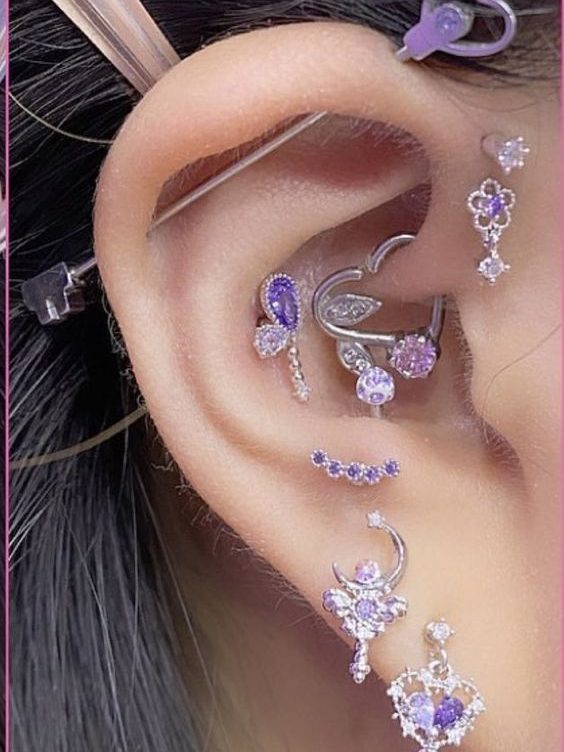
If the closure is partial, you may be able to put an earring through from either side.
What if the ear piercing is only partially closed?
Even if you’ve gone months or years without wearing earrings, you may still have a usable hole there, though it’s likely partially closed.
With a partially closed piercing, a thin layer of skin has grown over the hole, but there’s still a tunnel underneath it.
Resist the urge to break through the skin, even if you’re pretty sure you can do it. Even a tiny tear in the tissue can open you up to an infection or some bleeding.
Instead, try this on a partially closed-ear piercing:
- Take a bath or shower. The warm water will help soften the skin.
- Lubricate your ear with a non-antibiotic ointment (like Aquaphor or Vaseline) to keep the skin pliable.
- Gently stretch your earlobe to help open up the area and thin the piercing hole.
- Carefully try pushing the earring through the backside of the earlobe.
- Experiment with different angles, always using gentle pressure.
- Once in, keep the area clean and keep your earrings in for a few weeks to prevent the holes from closing.
- If reasonable force doesn’t work, you’re better off contacting a professional who can re-pierce your ear(s) for you. You don’t want to cause pain or damage by using too much force.
Wondering why you should stick with a non-antibiotic ointment? Unless you have an infection, using any type of antibiotic is not necessary. Also, antibiotic ointment can aggravate an open wound if you manage to break through the skin with an earring.
What if the ear piercing is closed off completely?
In such cases, you have one or two options – you could force it open if you don’t mind some messiness. However, we don’t recommend this approach since you could easily get the ear-piercing infected. If you have to re-pierce it all by yourself, take some precautionary measures. These include:
- Carefully clean and then disinfect the area with a clean microfiber or cotton material. You could also take a warm shower to make the ear softer and more malleable.
- Next, massage the piercing area with oil, for example, jojoba or emu oil.
- Gently pull the skin around the piercing apart in an attempt to make the piercing hole (previous location) wider
- Try to insert the earring from different angles slowly. Be very gentle and don’t force the earring. If there’s too much pain, stop.
- Instead (OPTION 2), we recommend seeking professional help (perhaps this is what you should have done in the first place).
Should you force it back open when it closed?
Like all things, it depends. Everyone is different, so I won’t say yes or no. Instead, you should try to gently play around with your piercing to see if it is simply a thin layer of skin that has grown over in your body’s attempts to heal itself. If this is the case, a small bit of pressure will pop your ring through with no pain or messiness.
These attempts can be easier after you’ve:
- Cleaned and disinfected the area and all your material
- Taken a shower, as your skin is much softer and malleable
- Massaged the piercing with a bit of oil (like emu oil or jojoba oil)
- Pulled the skin around your piercing a little to make the hole bigger, which can help to insert an earring
- Tried different angles of inserting, like from the back of the hole or by gently shifting the ring while you put it through
However, keep in mind that you are not a professional! I will say that again: you are not a professional. Piercings can be tricky; they are essentially open wounds. If you’re trying to do this on your own, and you just can’t manage to do it without feeling pain or some sort of panic that you’re going to screw it up, STOP.
My ear piercings keep closing, what should I do?
Despite all efforts, your ear piercings may close repetitively after you remove the earring. In most cases, the reason for this is an unhealed piercing or too much disturbance (at least in our experience).
So, to avoid all that mess, we recommend seeing a professional to have it fixed – perhaps getting it professionally re-pierced.
Once this is done, just leave the piercing stud in and stop bothering it even after you think it’s healed. Keep it clean always, and just stop trying different things.
Like everything else, all your ear may need is space. So. Give it time. But if the pain is too much, you may want to leave it be. Then when you are ready, get another piercing, perhaps closer to the original piercing, but not at the same spot.
Can you get re-pierced in the same spot?
Maybe, but only a piercing professional can tell you for sure.
Book a consultation with a piercing professional who can examine your former earring hole(s) and decide if you can re-pierce the same spot without opening yourself up to complications.
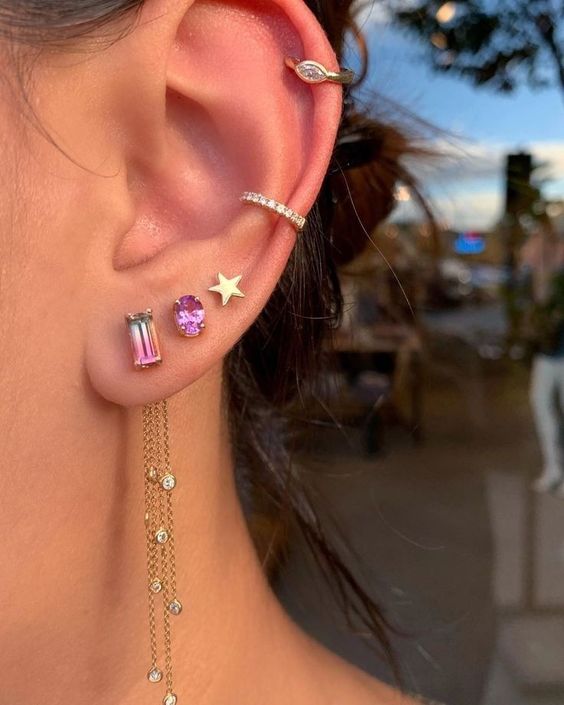
If your hole(s) closed due to an allergic reaction or because of an infection, piercing the same spot may not be the best idea — depending on how the area healed.
The piercing professional will check for issues in or around the old piercing that could make it hard to re-pierce, and they will advise you on how to proceed.
What if I have a lot of scar tissue?
Chances are, the piercing professional will advise you to pierce a different spot where there’s no scar tissue, especially if there’s quite a bit of it.
An infection, allergic reaction, or removal of your initial piercing earrings too soon could result in the development of scar tissue, like a hypertrophic scar or keloid. Some people are also just more prone to keloids.
Depending on how much scar tissue there is, you might be better off avoiding another piercing entirely. The same goes if you have or had a keloid in the past, This is because there’s a higher chance that you’ll grow another in your new piercing.
How to keep your ear piercing open without wearing a pair of earrings?
Generally, newly pierced ears require special care and attention for about six to eight weeks after the procedure. However, cartilage ear piercings may take longer to heal as it may take anywhere between three to twelve months to heal completely. Ensure you keep your original earring in for the entire duration and practice other aftercare procedures as advised by your piercer. After the first six to eight weeks, you can remove the earring for cleaning. However, it is best to quickly replace the earring in the new hole for a maximum of one full year to prevent it from closing.
Cut the ball off of a small post earring
If your current life circumstances do not allow you to enjoy your newly pierced ears, you may opt to keep your ear piercing open by cutting off the small ball in a pair of small and inexpensive post-earrings.
Remove the earrings back by pushing the post as forward as possible and snipping the ball off with wire cutters, while the earring is still inside your ears. Push the post earring back to its normal position. You may notice it somehow resembles a tiny mole.
If you opt to use this method, it is advisable to recruit the help of someone else to prevent injuring yourself or cutting the post earring inappropriately.
Make sure you observe extreme caution when using wire cutters that are close to your ears. You can opt to disinfect them before use to prevent various ear infections.
Use glass or quartz retainers
Clear glass or quartz jewelry is perfect for keeping the earholes of newly pierced ears open and discrete. While it is far from invisible, it is only detectable with reasonably close inspection.
Avoid plastic jewelry since they are a common cause of severe ear infections, especially if it is before the first six to eight weeks of getting the ear piercing.
It is advisable to visit your piercer and to have him/her change the earrings in the safest way possible.
Clear acrylic jewelry is not advisable due to its quality issues, but it is also a viable alternative. Most dermatologists and professional piercers recommend stainless steel or 14-karat gold earrings as the first earrings one should wear after an ear piercing since they are hypoallergenic.
Other jewelry metals may induce allergic reactions, which may cause severe ear infections.
Remove your earrings when necessary
If your situation calls for it and you have no viable options, it is best to completely remove the earrings once you are at work, school, or performing an athletic activity.
Ear holes do not close up as fast as you might think, especially if the six to eight-week window period is over. Different people heal at different rates, but you can be sure that your new ear piercing will not close up after a day or two.
However, a thin membrane will likely grow over your ear hole without actually closing the hole. You can simply push an earring through it with minimal pain and the least amount of effort. If you encounter any difficulty, lubricate the earring with some vaseline and antibiotic ointment to kill any germs and bacteria.
On the other hand, cartilage ear piercings can stay for longer durations of time without an earring and without closing. However, it is crucial to remember that their healing process takes longer than that of lobe ear piercings.
Ten articles before and after
Rhodium Plated Sterling Silver
Who Should Not Wear Tiger Eye Stone?
Which Side Should I Pierce My Nose?
Does Stainless Steel Turn Green?
Crooked Septum Piercing & 29 Things You Need To Know About The Septum Piercing
